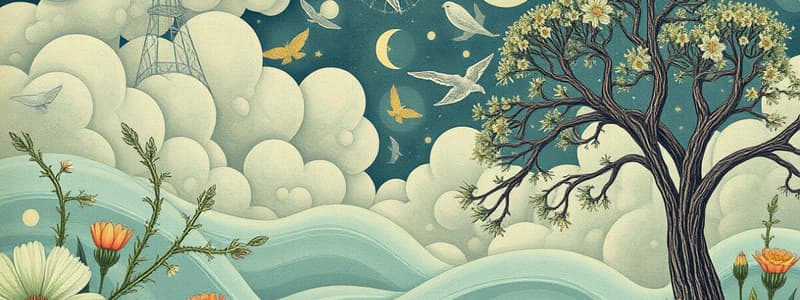Podcast
Questions and Answers
What is a primary contributor to greenhouse gas emissions from industrial activities?
What is a primary contributor to greenhouse gas emissions from industrial activities?
- Agricultural practices
- Deforestation
- Cement production (correct)
- Urban development
What effect does climate change have on precipitation patterns?
What effect does climate change have on precipitation patterns?
- Droughts in some regions and floods in others (correct)
- No effect on rainfall
- Uniform distribution of rainfall
- Increased rainfall everywhere
Which greenhouse gas is primarily emitted through livestock agriculture?
Which greenhouse gas is primarily emitted through livestock agriculture?
- Sulfur dioxide (SO2)
- Nitrous oxide (N2O)
- Carbon dioxide (CO2)
- Methane (CH4) (correct)
How does deforestation contribute to climate change?
How does deforestation contribute to climate change?
Which of the following is a direct consequence of climate change on animal behaviors?
Which of the following is a direct consequence of climate change on animal behaviors?
What is a possible result of increased global temperatures on animal habitats?
What is a possible result of increased global temperatures on animal habitats?
Which of the following risks is associated with climate change affecting wildlife health?
Which of the following risks is associated with climate change affecting wildlife health?
What is a significant impact of climate change on ocean ecosystems?
What is a significant impact of climate change on ocean ecosystems?
What kind of extreme weather events have increased in frequency due to climate change?
What kind of extreme weather events have increased in frequency due to climate change?
What alteration in land use is a factor contributing to climate change?
What alteration in land use is a factor contributing to climate change?
Study Notes
Causes Of Climate Change
-
Greenhouse Gas Emissions:
- Carbon dioxide (CO2) from burning fossil fuels (coal, oil, natural gas).
- Methane (CH4) from agriculture (livestock) and landfills.
- Nitrous oxide (N2O) from industrial activities and agricultural practices.
-
Deforestation:
- Trees absorb CO2; cutting them down increases atmospheric CO2 levels.
-
Industrial Processes:
- Production of cement, chemicals, and metals releases significant greenhouse gases.
-
Agricultural Practices:
- Use of fertilizers and methane emissions from livestock contribute to climate change.
-
Land Use Changes:
- Urbanization and conversion of land for agriculture alter natural carbon sinks.
Effects On Weather
-
Increased Temperatures:
- Global average temperatures rising, leading to heatwaves and altered climate patterns.
-
Extreme Weather Events:
- Increased frequency and intensity of hurricanes, floods, droughts, and storms.
-
Changes in Precipitation Patterns:
- More rain in some areas, leading to flooding; less in others, causing droughts.
-
Ocean Changes:
- Rising sea temperatures and acidification affect weather patterns and marine ecosystems.
Impact On Animals
-
Habitat Loss:
- Species losing their natural habitats due to rising temperatures and changing landscapes.
-
Altered Migration Patterns:
- Animals changing migration routes and timings due to temperature shifts and food availability.
-
Endangerment of Species:
- Increased risk of extinction for vulnerable species (e.g., polar bears, coral reefs).
-
Disruption of Ecosystems:
- Changes in food webs and predator-prey relationships due to shifting climate conditions.
-
Health Risks:
- Increased stress from temperature extremes and the spread of diseases affecting wildlife.
Causes of Climate Change
- Greenhouse Gas Emissions:
- Carbon dioxide (CO2) primarily generated from the combustion of fossil fuels such as coal, oil, and natural gas.
- Methane (CH4) emissions largely arise from agricultural activities, particularly livestock production, as well as from decomposing organic matter in landfills.
- Nitrous oxide (N2O) released from various industrial processes and certain agricultural practices contributes significantly to greenhouse gas levels.
- Deforestation:
- The removal of trees, which naturally absorb CO2, leads to higher concentrations of CO2 in the atmosphere, exacerbating climate change.
- Industrial Processes:
- Major industries like cement, chemical manufacturing, and metallurgy emit a considerable amount of greenhouse gases during production.
- Agricultural Practices:
- The use of nitrogen-based fertilizers results in nitrous oxide release, while livestock farming generates methane, both contributors to climate change.
- Land Use Changes:
- Urbanization and the conversion of forests and wetlands into agricultural land can disrupt existing carbon sinks and contribute to increased atmospheric CO2.
Effects on Weather
- Increased Temperatures:
- Global average temperatures are on the rise, resulting in more frequent heatwaves and altering traditional climate patterns worldwide.
- Extreme Weather Events:
- A notable increase in the frequency and intensity of natural disasters, including hurricanes, floods, droughts, and storms.
- Changes in Precipitation Patterns:
- Disparities in rainfall distribution, causing certain regions to experience excessive flooding while others face prolonged drought conditions.
- Ocean Changes:
- Rising sea temperatures and increased ocean acidification are affecting atmospheric conditions and the health of marine ecosystems.
Impact on Animals
- Habitat Loss:
- Many species are losing their natural habitats due to rising temperatures and environmental changes, resulting in diminished biodiversity.
- Altered Migration Patterns:
- Animals are adjusting their migration routes and the timing of their movements in response to temperature fluctuations and changes in food availability.
- Endangerment of Species:
- Particularly vulnerable species, like polar bears and certain coral reefs, face heightened extinction risks due to changing habitats and climatic conditions.
- Disruption of Ecosystems:
- Ecosystem dynamics are shifting, leading to changes in food webs and predator-prey relationships as species adapt to new climate realities.
- Health Risks:
- Wildlife experiences increased stress from extreme temperatures, alongside the increased spread of diseases as ecosystems shift and species interactions change.
Studying That Suits You
Use AI to generate personalized quizzes and flashcards to suit your learning preferences.
Description
This quiz explores the various causes of climate change, including greenhouse gas emissions, deforestation, and industrial processes. It also examines the effects on weather patterns, such as increased temperatures and extreme weather events. Test your knowledge and understanding of this critical global issue.




